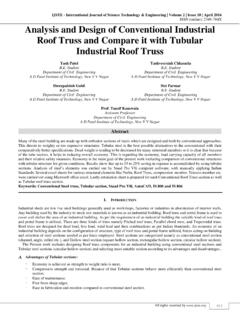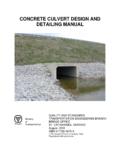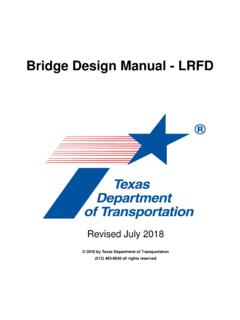Transcription of Analysis and Design of Box Culvert - IJSTE
1 IJSTE - International Journal of Science Technology & Engineering | Volume 4 | Issue 10 | April 2018 ISSN (online): 2349-784X All rights reserved by 141 Analysis and Design of Box Culvert P. Leela Krishna Dr. K. Rajasekhar Student Assistant Professor Department of Civil Engineering Department of Civil Engineering Andhra University, Visakhapatnam, India Andhra University, Visakhapatnam, India Abstract Box Culverts are required to be provided under earth embankment for crossing of water course like streams, Nallas across the embankment as road embankment cannot be allowed to obstruct the natural water way. The culverts are also required to balance the flood water on both sides of earth embankment to reduce flood level on one side of road thereby decreasing the water head consequently reducing the flood menace. Culverts can be of different shapes such as arch, slab and box.
2 These can be constructed with different material such as masonry (brick, stone etc) or reinforced cement concrete. Since Culvert pass through the earthen embankment, these are subjected to same traffic loads as the road carries and therefore, required to be designed for such loads. The size, invert level, layout etc. are decided by hydraulic considerations and site conditions. The cushion depends on road profile at the Culvert location. The structural Design involves consideration of load cases (box empty, full, surcharge loads etc.) and factors like live load, effective width, braking force, dispersal of load through fill, impact factor, co-efficient of earth pressure etc. Relevant IRC Codes are required to be referred in the Analysis and Design of box culverts. The aim of this project is to model and analyse the box Culvert using STAAD PRO software.
3 This software is an effective and user friendly tool for three dimensional model generation, Analysis and multi material Design . The results obtained from STAAD PRO are compared with the manual calculations obtained using MATLAB. The structural elements of box Culvert are designed to withstand maximum bending moment and shear force. The results obtained from STAAD are almost similar to manual calculations. Keywords: Staad pro, Mat lab, Excel Sheet _____ I. INTRODUCTION Introduction Box Culvert has many advantages compared to slab Culvert or arch Culvert . The box is structurally strong, stable and safe and easy to construct. The main advantage is, it can be placed at any elevation within the embankment with varying cushion which is not possible for other type of culverts. A multi cell box can cater for large discharge and can be accommodated within smaller height of embankment.
4 It does not require separate elaborate foundation and can be placed on soft soil by providing suitable base slab projection to reduce base pressure within the safe bearing capacity of foundation soil. Bearings are not needed. It is convenient to extend the existing Culvert in the event of widening of the carriageway at a later date as per future requirement, without any problem of Design and/or construction. The Culvert cover up to waterways of 6 m (IRC: 5-1981) and can mainly be of two types, namely, box or slab. The box is one which has its top and bottom slabs monolithically connected to the vertical walls. In case of a slab Culvert the top slab is supported over the vertical walls (abutments/ piers) but has no monolithic connection between them. A box Culvert can have more than single cell and can be placed such that the top slab is almost at road level and there is no cushion.
5 Types of Box Culvert Culverts are cross drainage works with clear span less than six meters. In any highway or railway project, the majority of cross drainage works fall under this category. Hence these structures collectively are important in any project, though the costs of the structures are small. Culverts may be classified according to function as highway or railway Culvert . The loadings and structural details of the super structure would be different for these two classes. Based on the construction of the structure, they can be of the following types. Types of Culverts Slab Culverts Pipe Culverts Box Culverts Box Culverts: Box Culverts are ideally suitable monolithic structures across a highway or railway embankment to balance the flood water on both sides. It consists of top slab, bottom slab and two vertical side walls. Reinforced concreterigid frame box culverts are used for square or rectangular openings with span up to 6m.
6 The top of the box section can be at the road level or can be at a depth below road level with a fill depending on site conditions. Analysis and Design of Box Culvert ( IJSTE / Volume 4 / Issue 10 / 029) All rights reserved by 142 Advantages of Box Culverts: Prevent Erosion Prevent Flooding Allow Water to Flow Unobstructed Divert Water for Farming/Engineering Purposes Objective of the Project The aim of this study is to achieve the following goals: - 1) To model and analyze box Culvert using STAAD PRO software. 2) To asses and compare the results of STAAD PRO and manual calculations. 3) To Design elements of the box Culvert as per IS specifications. Necessity of the Project Over the years ago engineers solving problems by using numerical methods. Due to development took place in structures and materials problems become more complex.
7 They can t solved those structures by using numerical methods. So they are going to solve those methods by using computational methods using Software. Hence in the present study an Analysis has been carried out by using STAAD Pro and the results obtained are compared that of manual calculations obtained using EXCEL and Mat Lab coding. Also box Culvert is designed for three conditions to study stresses in terms of bending moment and shear. 1) No water flowing in the drain. The box Culvert will be dry from inside, and sidewalls will be subjected to earth pressure from outside. 2) Water in box, will be subjected to earth pressure from outside and water pressure from inside. 3) Live load and dead load on top and water pressure from inside no live load on the sides. Applications of Box Culvert These are the following applications of the box Culvert .
8 Box Culverts in Road and Highway Construction: Box culverts are prevalent features in road and highway construction. In order to withstand traffic loads and aggressive weather conditions, these culverts must be tough that s why we recommend building yours out of concrete. These box culverts allow water to flow under roads and highways without impeding the flow of traffic. Box Culverts in Utility Work: Utility work also utilizes box culverts. These culverts serve as utility tunnels that carry electricity, water and sewer lines. Sometimes, they also carry communication lines, such as telephone and cable television. Utility tunnels are ideal for cold climates where it s difficult to bury lines below the frost level. They can also be found in areas where the water table is too high to bury water and sewer mains, or in areas like Tokyo where utility poles are likely to succumb to earthquakes or storms.
9 Box Culverts in Railroads: Railroad construction and maintenance relies on the use of box culverts. They can replace small bridges or create crossings over creeks or other waterways. Under track culverts are vital to the success of modern railroads. Various Types of Box Culvert Box Culverts Where pipe solutions are inappropriate, box culverts are the default buried structure type. Their larger openings are often required to provide adequate hydraulic capacity. Box culverts are also frequently used for pedestrian or cattle underpasses. The reinforcement used in concrete box culverts can be either conventional bar reinforcement or welded wire fabric. Welded wire fabric has yield strength slightly larger than conventional bar reinforcement. A typical box Culvert is shown in Fig Analysis and Design of Box Culvert ( IJSTE / Volume 4 / Issue 10 / 029) All rights reserved by 143 Precast Concrete Box Culverts Standard designs for precast concrete box culverts are available with spans varying from 2 to 5 m and rises varying from to 4 m.
10 Standard precast concrete box culverts are typically fabricated in 2 m sections; however larger boxes are fabricated in m sections to reduce section weight. The designs utilize concrete strengths are suitable for fill heights ranging from less than m to a maximum of m. Box culverts outside of the standard size ranges must be custom designed. Each Culvert size has three or four classes. Each class has specified wall and slab thicknesses, reinforcement areas, concrete strength, and fill height range to which it applies. To prevent corrosion at the ends of welded wire fabric, nylon boots are required on the ends of every fourth longitudinal wire at the bottom of the form. A maximum of two layers of welded wire fabric can be used for primary reinforcement. If two layers are used, the layers may not be nested. A typical section of precast box Culvert is shown in Fig Cast-In-Place Concrete Box Culverts The first box culverts constructed in Minnesota were made of cast-in-place concrete.



